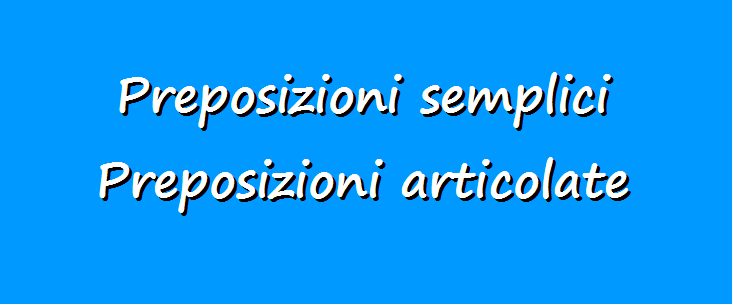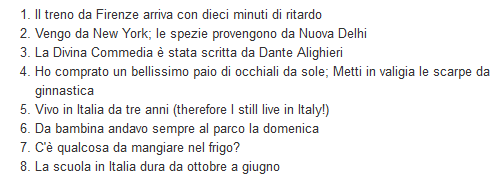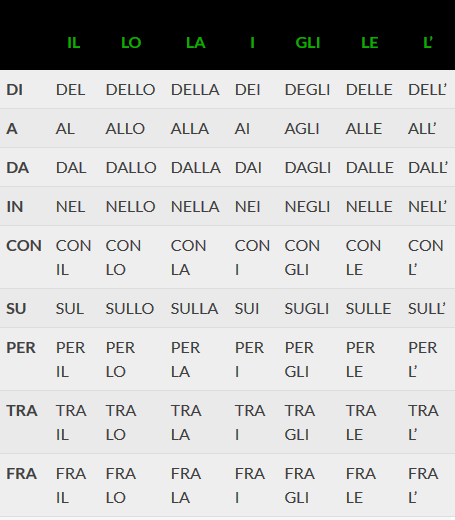
Prepositions are invariable (they do not change) items in the Italian language, and they are used to connect words or sentences.
They can be followed by a noun, a pronoun, an infinitive verb, and they can have, as in other languages, many different meanings and uses, according to the context.
Don’t worry….time, practice, and passion for Italy and its wonderful language will help you in the study of prepositions!
Simple prepositions in the Italian language
Let’s start with the most common uses of simple prepositions:
The preposition “di”
- Can indicate who is the owner of something
- Can express the material of which an object is made
- Can introduce the origin of someone or something (verb to be + di)
- Can indicate the age of someone or something
- Is used when before an adjective there is an indefinite pronoun
Examples:
The preposition “a”
- Is used with names of cities and small islands (or what the Italians consider to be small islands!)
- Is used to introduce a time, a month, an age
Examples:

The preposition “da”
- Can indicate an origin
- Is used with verbs indicating where a movement has started
- Can express who does something
- Indicates the function of an object
- Introduces a period of time begun in the past and not yet concluded
- Indicates a particular moment in time, or a condition in the past
- is used when, before an infinitive verb, there is an indefinite pronoun
- Is often used together with the preposition A in the expression “da…a…” to indicate a well-defined period of time
Examples:

The preposition “in”:
- Is used with the names of nations, continents, regions, streets, and big islands
- Is used with means of transport (however, we say “andare a piedi”
- Is used with names of places that end up in -ia
Examples:
 The preposition “con”:
The preposition “con”:
- Can indicate company, participation, correspondence, and is usually used with verbs that indicate relationships between objects or people
- Can introduce a way to do something or reach a certain objective
Examples:
The preposition “su”:
- Is used to introduce a topc
- Can indicate the position of something which is higher, or on top of something else
Examples:

The preposition “per”:
- Is used to indicate a destination
- Is used to indicate going through something
- Is used to indicate the time by which something happens or must be done
- Is used to indicate a precise period of time
- Can indicate the cause of something
- In the structure “per + infinitive”, it expresses the aim for which something is done
- Indicates the receiver of a benefit
Examples:

The preposition “tra” o “fra”:
- Can be used to talk about a time or a place, and in particular to indicate something which is clearly defined between two points
- Is used to express a period in the future
Examples:

Articulated prepositions in the Italian language
Sometimes prepositions are followed by a definite article. In this case, the prepositions di, a, da, in, su join the article to form a single word: an articulated preposition. Con, per, tra, fra can also be followed by an article, but in this case the two words remain separate. Look at these table to understand how they are formed….it seems complicated but the method is always the same.

Articulated prepositions have the same function of simple prepositions, though it is not always easy for learners of the Italian language to understand when to use them. The problem is that it is not possible to establish a rule on when to use them, though some patterns can be noticed:
- Most of the time, articulated prepositions are used when the name that follows is in the plural form and/or when it is definite, and not generic:

- Never use an articulated preposition before the name of a city:
- Use an articulated preposition before names of regions, states, continents, big islands, seas, rivers, lakes and mountains
- Never use articulated prepositions before names or surnames:
We have written above that articulated prepositions have the same functions of simple prepositions, with the only difference of being united with (or followed by) an article. There is however a particular case:
- In Italian, the indefinite article uno, una, un does not have a plural form. Its plural can be formed by using the words alcuni/alcune, but also by using the articulated prepositions dei, degli, delle:
Related links:
- A text to improve your understanding of prepositions
- Two songs that use many prepositions: Vieni via con me and Mattinata Fiorentina
- A page with exercices on simple and articulated prepositions